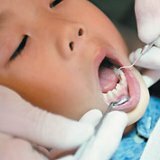Aphthous stomatitis in children

Aphthous stomatitis is one of the types of stomatitis that is characterized by the presence on the mucous membrane of the mouth of painful ulcerative defects - aft. This kind of stomatitis is one of the most unpleasant types of stomatitis, since it gives the patient considerable discomfort.
Causes of the appearance of
Various infections of an infectious nature cause and promote the development of aphthous stomatitis: adenovirus, herpes virus, diphtheria, staphylococcus( L-form), influenza, measles and others.
In addition, to serve as catalysts contributing to the onset of the disease, can be:
- Weakened immunity;
- Propensity for allergic reactions
- Deficiency of vitamins and trace elements( selenium, iron, vitamins B and C, zinc and others)
- Mucous membrane of the mouth
- Heredity
- Digestive diseases
- Mechanical damage to the mouth, for example, damage to the mucous tooth, bite or rough food
Very often aphthous stomatitis develops in children. For people between the ages of twenty and forty, a chronic aphthous stomatitis is already characteristic.
Symptoms and stages of development of
In the first stage, aphthous stomatitis resembles ARI:
- General malaise
- Increased body temperature
- Increased cervical and occipital lymph nodes
- Loss of appetite
Also at this stage, development of redness occurs, which then becomes the focus of the formation of aphthae. Afts are formed as sores with a diameter of 5 mm( single and multiple) and are the main symptom of the disease.
They usually appear on the mucosa of the cheeks, lips, bottom of the mouth or tongue. Aphids are covered with a fibrous yellow or gray coating with a smell and are surrounded by a reddish fringe.
When the sores appear, general malaise persists, and besides, when eating, laughing, talking, discomfort appears.
Types of stomatitis
Aphthous stomatitis is divided into two types according to the nature of the course:
Chronic recurrent. This stomatitis occurs for a long time with periods of exacerbation and remission( exacerbation usually happens in the fall and spring).About forty cases of one hundred exacerbations are caused by mechanical damage to the oral mucosa. Over time, as a rule, the severity of relapses of stomatitis only grows, the number of sores increases, and the healing time can extend for a month.
Sharp. This kind of stomatitis develops after a viral infection.
Stomatitis is divided into three types according to the nature of the lesion: deforming, scarring and necrotic.
Diagnostics
A dentist can diagnose aphthous stomatitis. To clarify the diagnosis, a specialist usually prescribes taking a smear from aft.
Treatment of
Therapy for aphthous stomatitis in children has as its goal the complete disposal of the disease or a stable remission. Achieving both goals is possible with the help of general or local therapy - it all depends on the clinical situation.
To begin with, it is necessary to treat the oral cavity of the child and the sores directly with an antiseptic drug. You can process both at home and in the clinic with a specialist.
Typically, the therapy consists of periodic rinsing of the mouth with special antiseptic drugs( chlorhexidine, furacilin, hydrogen peroxide and others) or decoctions from medicinal plants.
If necessary, the child can take antihistamine, antipyretic and other drugs( drugs with hydrocortisone, lidocaine, novocaine, heparin, etc.).Such drugs can improve the general condition of the child.
To accelerate the healing of ulcers, citral solutions, preparations with propolis and vitamins C and P are used.
If stomatitis is caused by an infectious disease, then sometimes antiviral therapy is performed.
When treating, it is also necessary to follow a diet: do not eat acidic, rough, spicy or hot food, as it causes irritation of the mucosa. It is also advisable to start taking vitamins B and C.
In order to avoid subsequent relapses it is necessary to maintain immunity at a sufficiently high level.
If stomatitis is not treated, ulcers will disappear within a week or two themselves, but the disease can go into a chronic form, which is almost not cured.



